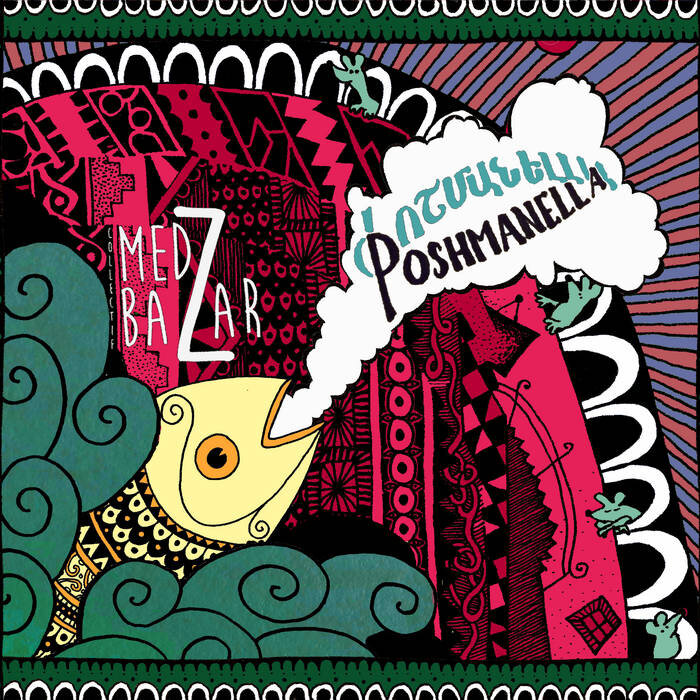One of the themes of our NHLF grant is Neighbours, what we share, what we learn from each other, how we do or do not get along. One of the things we have constantly been exchanging with neighbours is music. It’s an art that doesn’t recognise borders, governments, political affiliations or wars. It’s also an art which is part of our everyday life, accompanying us in our headphones, on the radio, at workplaces, during religious rituals, football chants or singalongs from balconies when quarantined for coronavirus.
I find this exchange and sharing of music fascinating and have woven together an eclectic mix of examples. These songs and their various interpretations and covers are all united by Armenian connections.
Charles Aznavour: Stenka Razin’s song
The first song is from Charles Aznavour, our much-loved and admired singer and lyricist and here is an interpretation of a famous Russian song about a Cossack hero – Stenka Razin. It’s fascinating to think about the geography of this cover – a French Armenian, with roots from Georgia and Turkey, singing about a Russian-Tatar ataman, who is about to marry a Persian Princess.
Stenka (Stepan) Razin led an uprising against nobility and the tsar and is one of the most admired and enduring characters in Russian folklore. There are many songs and ballads about him, but this one – Volga-Volga (or simply, Stenka Razin’s song) must be the most popular but the darkest one. Lyrics are written by Dmitri Sadovnikov (Russian poet and ethonographer) in 1883 based on a folk melody.
It’s the fictional story of Stenka and his Cossacks sailing on the Volga river and Stenka’s drunk men whispering that their leader has lost his head since meeting a woman. Overhearing it, Stenka Razin angrily states that he will prove he cares for his people more, and throws the unfortunate princess into the water - and orders his shocked men to sing and dance.
Here is Aznavour’s emotional French version, and if you didn’t know the lyrics, you could easily mistake it for a tender love song. Interestingly, the first Russian narrative film is based on this song, made in 1908 and this video uses the footage from that film.
Medz Bazar: Bobik Djur Mi Era | Yaro Jan
The band describes their music as: ‘On stage, Collectif Medz Bazar balances tempered instruments with music from modal traditions, including Middle-Eastern percussion and Parisian voices of various origins (Armenian, Turkish, and French-American), inspired by folk music from Asia Minor and Iran, Caucasian Rabiz and rhythms from Thrace, with touches of Venezuelan sounds, operette, hip-hop, jazz and bluegrass’’.
Whatever their own ethnic heritage, the band members learn the songs in the various languages and their enjoyment shows in the videos and in their music. Medz Bazar’s repertoire spans cultures in their arrangements of well-known folk songs but also with their own original compositions in various languages. Some of these are satires and social critiques, some are just fun (see Kokorec below), others explorations of the different sides of love. None of these recognise boundaries and aspects of each are found in societies everywhere. The band has been together for many years now and played across the US, including South by Southwest Festival (SXSW) and Innovate Armenia, in Moscow, Yerevan and Gyumri, many times in Turkey, including Istanbul and Diyarbekir, of course Paris and….. London!
The Armenian Institute has organised two sell-out concerts with this wonderful band and we hope to see them in London again.
Listen (and dance) to their energetic, fun interpretation of 2 Armenian folk songs: Bobik Djur Mi Era and Yaro Jan:
A great example of early Medz Bazar is their composition Kokoreç – Video shot in Paris, sung in Armenian and French – a hymn to a delicious tripe sandwich made in Istanbul.
The Beautified Project I Have Two Homes (Sayat Nova Cover)
Martiros Saryan: Sayat-Nova
Sayat-Nova is the perfect example of a musician who transcended linguistic and national boundaries with his art. A poet, musician and ashough whose songs are in Armenian, Georgian and Turkish, he was heavily influenced by Persian poetry and songwriting traditions.
One of his reworkings of a Georgian folk song was picked up by the Armenian bard Artur Meschyan in the early 2000s. Meschyan wrote lyrics for the melody, staying faithful to Sayat-Nova’s original lyrical compositions. And here is a beautiful cover of ‘I Have Two Homes’ by London-based band with Iranian-Armenian roots, The Beautified Project.
The band’s frontman Andre Simonyan says: ‘’music is sound and sound knows no man-made borders. It can travel from one country to another without any interruption caused by man-made territorial limitations’’.
The Chorus of Leblebijis from Dickran Chukhajian’s 'Leblebiji Hor-Hor Agha' Operetta
Leblebiji Hor Hor Agha operetta troupe in 1970s
Considered the first original Turkish operetta, this was written by an Armenian composer, Dikran Chukhajian, and based on the libretto by Takvor Nalian in Constantinople in 1875. It’s a story of two couples in love, dressing up, kidnappings, amorous misunderstandings and crooked villains. The operetta has been translated and performed in many languages including Armenian, Greek, German etc – but retains its joyful Italian musical influences in every interpretation, like in this Turkish version. https://www.youtube.com/watch?v=WAA-XZHuEEk
The part of the angry Leblebijis (chickpea sellers) is one of the most entertaining choruses from the operetta, demanding that Hor-Hor Agha’s daughter be returned to her father and reminding everyone about their brave ancestors. http://www.museum.am/songs/74.html
Its Armenian version became even more popular after the release of the film ‘Karine’, based on ‘Hor-Hor Agha’. You can watch a snippet from the film here, and listen to this wonderful version:
By Tatevik Ayvazyan





